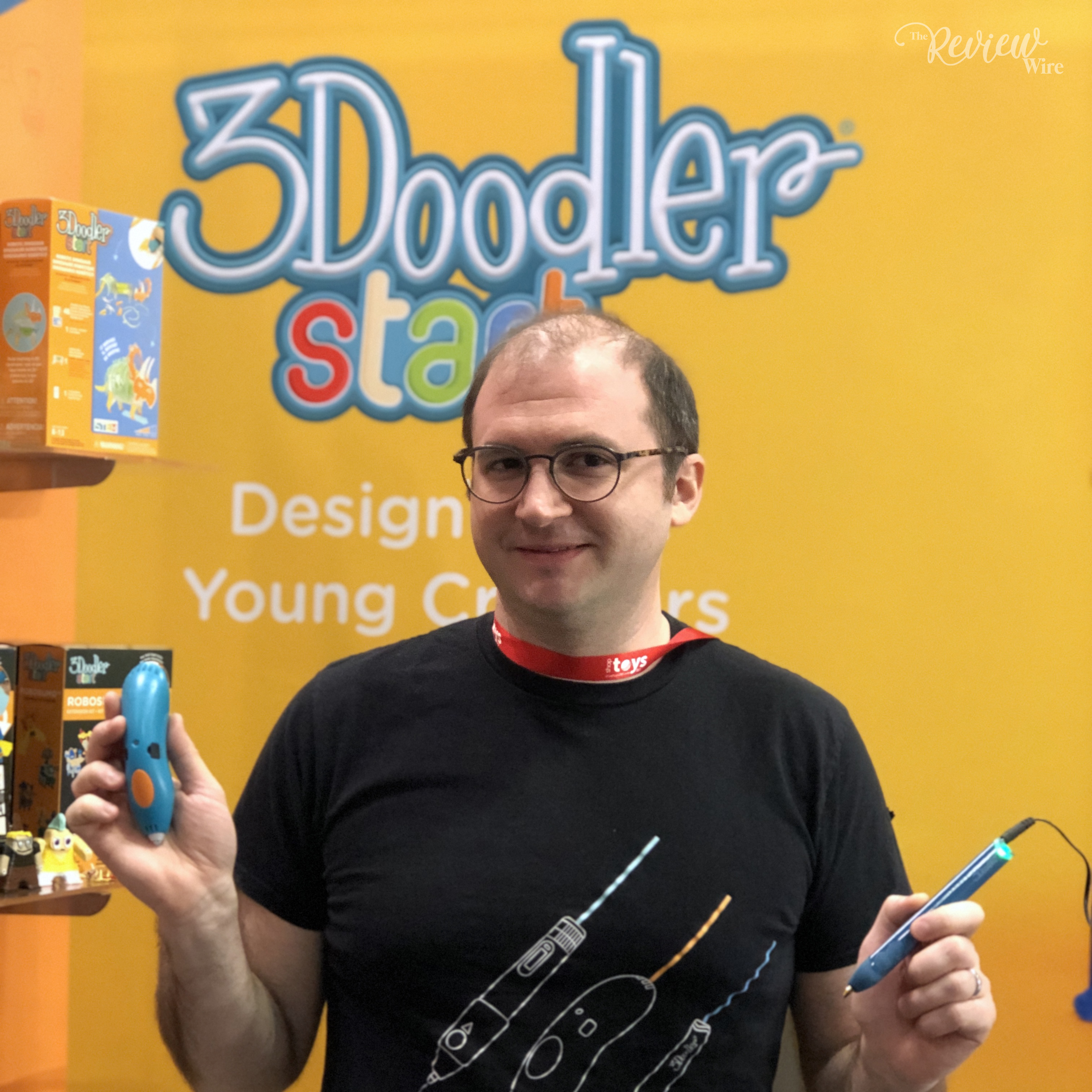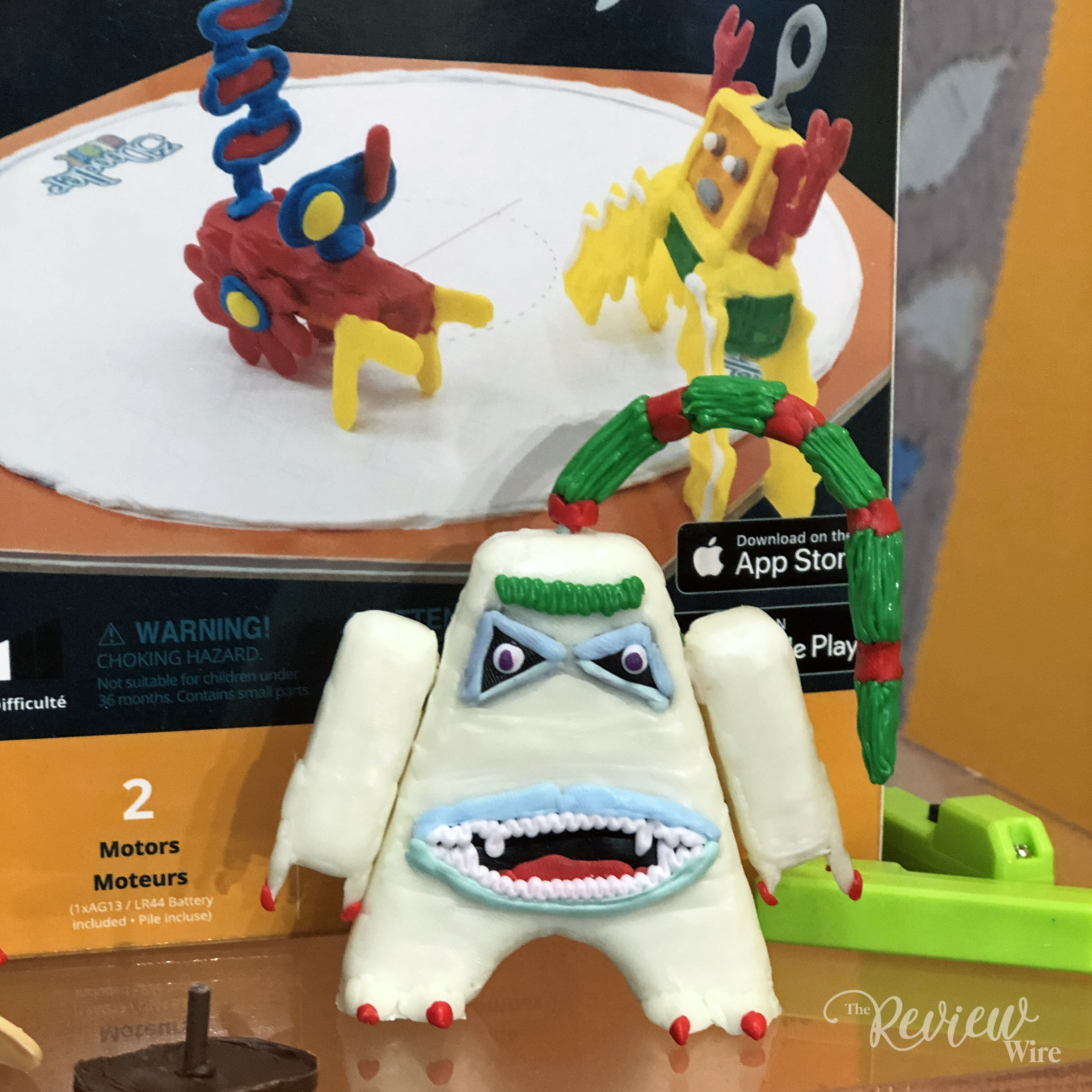This post may contain affiliate links. The Review Wire may collect a share of sales if you decide to shop from them. Please see my full disclosure policy for details.
Last month, we (Chatty Patty’s Place and myself) attended the New York Toy Fair. We met Maxwell Bogue the inventor and creator of the 3Doodler! If you have not heard of the 3Doodler before, let me tell you a bit about it. A 3D pen is a pen that extrudes heated or warm plastic from the pen’s nozzle. You don’t need any software. There are no files to transfer, and no difficult tech to master.
With a 3D pen, you can draw a raised graphic on a piece of paper or any flat surface. But what makes a 3D pen truly unique is its ability to “draw” in mid-air, allowing you to instantly form 3D structures right in front of you, which you can pick up and hold in your hand.

Patty and I had a chance to interview Maxwell about his invention.
CPP: How was the 3Doodler created?
Maxwell: My business partner (Peter Dilworth) and I were working on a Robot Dinosaur. We were almost finished printing out the dinosaur’s leg — a 14-hour printing job– when the printer made a mistake and missed a layer. We were obviously frustrated, and Pete noted what a shame it was that we couldn’t just take the extruder head off the printer and fill in the gap. That’s when we realized, why couldn’t we? Once we did, we quickly became excited about the possibilities of a manual 3D printer and even drawing in the air. The next day we made a quick and dirty prototype that worked badly, but it worked. We wrote 3Doodler on the side of that very first prototype, kept improving it and never looked back.
TRW: How long did it take from concept to finished product?
Maxwell: From creating the initial prototype to having a product we were ready to ship to our very first users took just over a year and a half. We spent most of that time experimenting and refining the device to give users the best possible doodling experience.
CPP: What did you do for a living before the 3Doodler?
Maxwell: Before founding WobbleWorks Inc. (the parent company of 3Doodler), I was a Director of Consumer Robotics at Handy Robotics and an R&D Manager at WowWee, launching products like Rovio, RS Media, and ChatterBots.
TRW: What do you think you’d be doing if you didn’t create the 3Doodler?
Maxwell: I’d still be inventing and hopefully creating amazing products, just not on the 3Doodler.
TRW: What is the coolest thing you have seen created with the 3Doodler?
Maxwell: We’ve seen so many amazing things done with the 3Doodler that we created a coffee table book to showcase them!
If you asked me for a recent favorite, a German artist named Connie Kuglmeier spent nearly two months building a six-foot, six-inch replica of the Statue of Liberty that used more than 1,000 strands of PLA and 3Doodler Start plastic. We were supposed to have it at 2018 New York Toy Fair, but it got lost in customs. Thankfully it made it to our office in New York City where it currently lives. Another highlight for me is the life-size car made by a team of artists in the UK led by Grace DuPrez to celebrate the launch of a new model by Nissan.
CPP: I understand 3Doodler is used in classrooms. Can you talk about that a bit?
Maxwell: It’s been an amazing experience to see how the 3Doodler pens have been impacting students in the classroom. The 3Doodler Start is being used in kindergarten and elementary school, while the 3Doodler Create+ is being used in high schools and colleges. Teachers have been using it in every subject, from building a collaborative temple in history class to making roller coasters in physics class. The 3Doodler has the unique ability to bridge different learning styles. Unlike a traditional 3D printer, the 3Doodler provides a hands-on activity and it comes at a much lower cost. We are able to sell specially designed Learning Packs of 6 or 12 pens plus everything else a teacher needs to use the pen in a classroom for less than a traditional 3D printer. Another advantage is that all the students in a class can doodle at once, as opposed to a traditional printer which only one student can use at a time.
For me, one of the biggest and most exciting impacts that we are seeing is with special needs students. We have seen a positive impact on students with Dyslexia, ADHD, Autism and the blind and partially sighted. We’re proud to have collaborated with the RNIB (Royal National Institute for the Blind) to earn the 3Doodler Start their official endorsement, a quality assurance mark for products identified as “easy-to-use” for those who are blind or have sight loss. It’s there has been such an easy-to-use device for the blind to use to make a raised line, so the possibilities are endless from graphing in math class to the ability to write traditional letters and make tactile maps.
All in all, we are in over 5,000 schools and counting, and I can’t wait to see how the 3Doodler helps to prepare the next generation for careers that don’t even exist yet.
CPP: What are your future plans for 3Doodler?
Maxwell: We will continue to develop the best 3D printing pens on the market!
The Create+ is the fifth generation of our original Kickstarter product, so users who have embraced 3Doodler over time have noticed the continued improvement over the last six years. The Create+ not only works with plastics like ABS, FLEXY, and PLA, but wood filaments, which open up several home improvement opportunities, like fixing a floorboard.
We always have more innovations on the horizon!

TRW: What advice would you give to someone with a dream of an invention?
Maxwell: The best advice I can give is to go work for someone else that makes physical products first. Learn how to turn an idea into a finished product before you try to do it on your own. Keep your idea and learn how to implement it, rather than just throwing it up on the internet and assuming you can figure out a way to make it later.
Stay Connected:
- Visit 3Doodler.com
- Visit 3Doodler on Instagram
- Tweet with 3Doodler on Twitter
- 3Doodler on Amazon


Leave a Reply